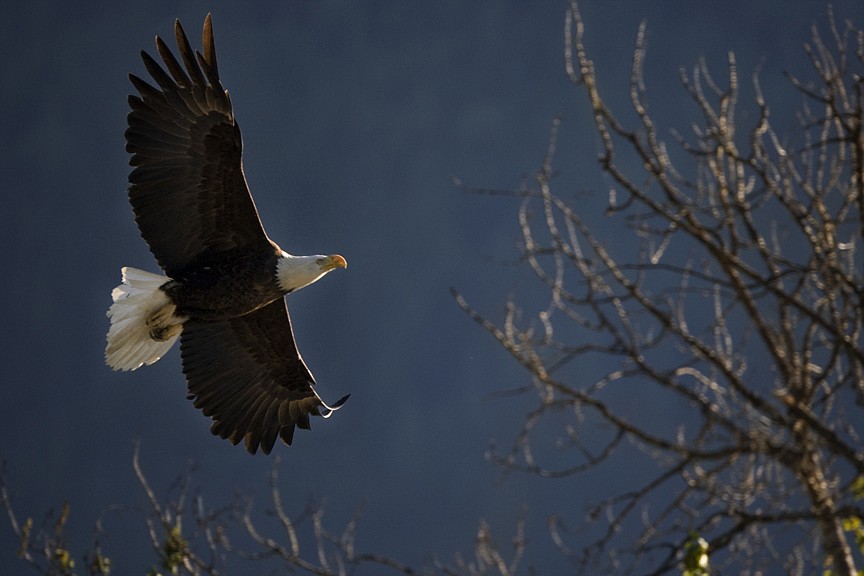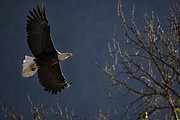Birding a therapeutic hobby during strange times
When the COVID-19 pandemic forced many people into quarantine back in March, I noticed some of my neighbors and peers on social media taking on brand new hobbies to combat the isolation.
Some took up painting. Some tried to bake sourdough bread. I decided to start birdwatching.
For a born-and-bred Montanan who will grasp at any excuse to spend more time in the outdoors, birding is a natural fit. And even more so while we were encouraged to spend time apart from one another during the pandemic.
But while identifying the robins and European Starlings and wild turkeys was easy, my new hobby became exceptionally more difficult once the migratory birds – the sparrows and swallows and warblers and vireos – started arriving in my backyard in April.
Is that a tree swallow or a violet-green swallow? What species of vireo is that, if it even is a vireo? What’s the difference between a finch and a sparrow? I would hurriedly flip through my Field Guide to North American Birds, trying to identify the bird before it flew out of sight.
Clearly, I had to call in reinforcements to step up my birding game.
I purchased a proper pair of binoculars – there are many excellent starter binoculars for less than $150 – and got in touch with some experts. Fortunately, there is no shortage of experienced birders in the Flathead Valley, and in other years I would join the Flathead Audubon Society on a guided trip, but those trips have been canceled due to COVID-19.
Instead, I had the Flathead Audubon Society’s conservation educator Denny Olson take me on a morning birding expedition. Olson is a passionate birder and environmental advocate who many know as “Doc Wild,” Olson’s theatrical alter-ego who provides “educational entertainment” about the natural world.
Olson took me to the West Valley Bird and Wildlife Viewing Area, a relatively new 400-acre wildlife refuge with access to prime wetlands and bird habitat. It was a chilly and overcast morning, and the lack of direct sunlight would make identification a little trickier, Olson said.
“If you’re a beginning birder, waterfowl is a great place to start,” he said. At that point, I had only been birding in the woods, where the birds are uncooperative, fidgety and tend to get lost among the branches and lush vegetation of Northwest Montana forests.
I told Olson about my issues so far, and he agreed that birding can be frustrating at first. But like any hobby, it just takes experience.
According to Olson, there are 450 species of birds in Montana and 18,000 species in the world. While this sounds overwhelming, once you start to figure out a bird’s behavior, shape, preferred habitat and field marks – the distinctive visual features, like spots or stripes, that make a species identifiable – it becomes a lot easier to narrow down the possibilities.
The process of discovering a new bird should not be frustrating, but part of the joy, Olson said. And once you’ve gone through the process of identifying a bird, you’ll probably remember that bird for the rest of your life.
It certainly helps to have the right resources, which is easier than ever in the age of smartphones. I was using the Merlin Bird ID app while Olson had the Sibley Birds guide on his phone. These offer a great alternative to lugging a heavy guidebook into the field.
While birding at the West Valley Refuge, we identified at least 20 new birds I did not have on my meager list. American coots dominated the proceedings on the pond, but others, such as red-necked grebes, American wigeons, cinnamon teal and gadwalls swam gracefully among each other. Dozens of squawking yellow-headed blackbirds perched on cattails provided the soundtrack.
But it was the ruddy ducks that offered the most entertainment. The male ruddy duck, with its baby-blue bill and long, pointy tail, is easy to identify. We watched two males attempt to court at least two females by raising their tails over their backs, smacking the water with their bills and making quick, clumsy spurts across the water, splashing their potential suitors.
Birding is a “multisensory experience,” Olson said. He also called it “ecotherapy,” and said people who spend more time outdoors have been scientifically shown to be happier and healthier individuals.
Olson stressed that it takes time to build your knowledge base as a birder, but once you start, “you never quit birding,” he said. “I learn something new every time I go out.”
While many birders, like Olson, have not made photography a part of their birdwatching, birds can offer an exciting and challenging photography experience. Joshua Covill, an expert local birding guide who has been birding since he was 13, got his first real camera in 2009 and has leveled up his equipment multiple times since then. He said if “recording what you see” becomes an important part of your birding experience, photography offers a great medium.
There is no need to be too ambitious at first. “The easiest birds to photograph are ones in your backyard,” Covill said.
Waterfowl are relatively simple, but Covill said it can be difficult to find a location in the Flathead Valley that allows you to get close enough for high-quality photos. Then there are the forest birds like warblers and flycatchers – by far the most difficult.
Of course, photography can come with a serious financial commitment. Covill said some of the “huge” lenses used by many professional photographers “cost more than any car I’ve ever bought in my life.”
If you want a simple visual record of a bird, you could try “digibinning,” which is putting a small camera, like a smartphone camera, up to the lens of your binoculars. The technique can be difficult – my attempts with Woodland Park mallards were disappointingly blurry – but it has the potential to be a great tool.
Covill said he has a friend who is doing a digibinning “Big Year” – trying to see how many species in a year he can capture through this technique.
But photographing the birds is hardly a requirement for a birdwatcher. Even for a talented photographer like Covill, photography is still a “secondary” part of the birding experience.
“For a beginner birder, I would suggest looking at what your joys are in birding. What are your priorities?” Covill said.
Covill said there are many things about birding that bring him joy, from the chance to spend time in nature to keeping lists of birds he has seen in Flathead County, Montana and around the world. He said his Montana list sits at 319 species of birds.
“It’s a multidimensional experience,” he said.
Covill said birding will also “open up your perspective” to not just the birds, but the entire natural world. Once you start noticing birds, he said, you may begin paying more attention to other parts of the natural landscape, like the wildflowers.
“It grounds you,” Covill said. “You’ll have a much deeper and fuller idea of the landscape you’re in … and the ecosystem around you.”
If you establish this perspective, “going outdoors” does not have to mean a long excursion to Glacier Park for a backcountry hike, or a weekend camping trip off the grid. Birding can be done anywhere. One could walk down a street in Kalispell with a pair of binoculars, listening to the orchestra of songbirds, and find themselves with an unexpected connection to the natural world.
In the early days of quarantine while trying to establish some semblance of a routine, it felt like the world was encouraging us to hunker down indoors and wait until the virus disappeared. But I could not set aside the importance of getting outside. And birding offered a ticket out the front door.
Sometime in April, right outside my window, the songbirds were starting to arrive. Maybe in previous years, they would have been nothing more than wallpaper while I sat at my computer.
But instead, it was time to grab the binoculars and head outside.





